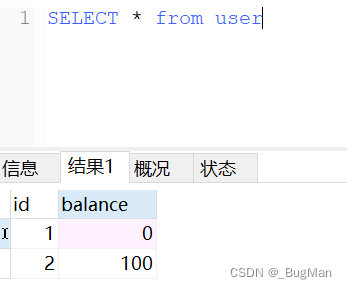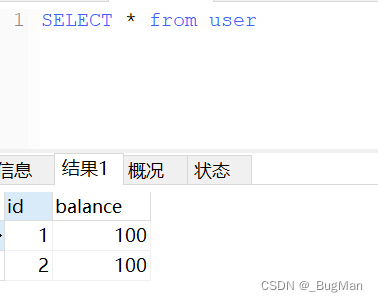详解Spring事务

目录
1.声明式事务
1.1.概述
1.2.使用
1.2.1.建表
1.2.2.maven依赖
1.2.3.配置
1.2.4.业务
1.2.5.测试
2.事务的传播行为
1.声明式事务
1.1.概述
spring中事务分为两种:
1.编程式事务,通过写代码来实现,每一步。
2.声明式事务,直接通过配置来实现。
常用的是声明式事务,接下来介绍的也是声明式事务。
1.2.使用
1.2.1.建表
一个用户表,有id和账户余额两个字段。
CREATE TABLE user (id INT(255) AUTO_INCREMENT PRIMARY KEY,balance INT(255)
) ENGINE=InnoDB DEFAULT CHARSET=utf8;insert into user VALUES(NULL,100),(NULL,100);1.2.2.maven依赖
<properties><spring.version>5.2.0.RELEASE</spring.version>
</properties><dependencies><dependency><groupId>org.springframework</groupId><artifactId>spring-core</artifactId><version>${spring.version}</version></dependency><dependency><groupId>org.springframework</groupId><artifactId>spring-context</artifactId><version>${spring.version}</version></dependency><dependency><groupId>org.springframework</groupId><artifactId>spring-tx</artifactId><version>${spring.version}</version></dependency><dependency><groupId>org.springframework</groupId><artifactId>spring-jdbc</artifactId><version>${spring.version}</version></dependency><!-- 数据库连接池 --><dependency><groupId>com.mchange</groupId><artifactId>c3p0</artifactId><version>0.9.5.5</version></dependency><!-- 数据库驱动 --><dependency><groupId>mysql</groupId><artifactId>mysql-connector-java</artifactId><version>8.0.18</version></dependency>
</dependencies>
1.2.3.配置
尤其要注意命名空间不要少引入!!!
<beans xmlns="http://www.springframework.org/schema/beans"xmlns:xsi="http://www.w3.org/2001/XMLSchema-instance"xmlns:tx="http://www.springframework.org/schema/tx" xmlns:context="http://www.springframework.org/schema/context"xsi:schemaLocation="http://www.springframework.org/schema/beans http://www.springframework.org/schema/beans/spring-beans.xsdhttp://www.springframework.org/schema/tx http://www.springframework.org/schema/tx/spring-tx.xsd http://www.springframework.org/schema/context https://www.springframework.org/schema/context/spring-context.xsd"><!-- 数据源配置 --><bean id="dataSource" class="com.mchange.v2.c3p0.ComboPooledDataSource"><property name="driverClass" value="com.mysql.jdbc.Driver" /><property name="jdbcUrl" value="jdbc:mysql://localhost:3306/springtest?useUnicode=true&characterEncoding=utf8&useSSL=false&serverTimezone=UTC" /><property name="user" value="root" /><property name="password" value="admin" /></bean><bean id="jdbcTemplate" class="org.springframework.jdbc.core.JdbcTemplate"><constructor-arg ref="dataSource" /></bean><!-- 配置事务管理器 --><bean id="transactionManager" class="org.springframework.jdbc.datasource.DataSourceTransactionManager"><property name="dataSource" ref="dataSource" /></bean><!--开启注解扫描--><context:component-scan base-package="com.eryi.service"></context:component-scan><!-- 启用事务注解 --><tx:annotation-driven transaction-manager="transactionManager" />
</beans>1.2.4.业务
这里模拟id为1的用户向id为2的用户转账100块,转账有两步组成:
- id为1的用户账户扣100块
- id为2的用户账户增加100块
在两步中模拟一个异常,导致只有只完成了id为1的用户扣100块的SQL执行了,但是id为2的用户增加100块的SQL没有执行。
import org.springframework.beans.factory.annotation.Autowired;
import org.springframework.jdbc.core.JdbcTemplate;
import org.springframework.stereotype.Component;
import org.springframework.transaction.annotation.Transactional;@Component
public class UserService {@Autowiredprivate JdbcTemplate jdbcTemplate;@Transactionalpublic void transfer(){try {// 从 fromUserId 账户中扣除金额jdbcTemplate.update("update user set balance = balance - ? where id = ?", 100, 1);// 抛出异常,测试事务是否回滚int i = 1 / 0;// 将金额转入 toUserId 账户中jdbcTemplate.update("update user set balance = balance + ? where id = ?", 100, 2);} catch (Exception e) {throw new RuntimeException(e);}}
}1.2.5.测试
public static void main(String[] args) {ApplicationContext applicationContext=new ClassPathXmlApplicationContext("applicationContext.xml");UserService userService = applicationContext.getBean("userService", UserService.class);userService.transfer();}如果没有事务的话,会是这种情况:

有了事务的话,事务中所有SQL会具有原子性,要么全部成功,要么全部失败,会是这个结果:

2.事务的传播行为
Spring中存在着一个概念——事务的传播行为。事务的传播行为指的是一个事务方法被另一个事务方法调用,即嵌套事务,出现异常该怎么回滚。
Spring规定有7种事务的传播行为:
| required | 如果出现异常的方法有事务就用这个事务,没有的话再去用其他的事务。例如:方法A调用方法B,如果B出现异常,B有事务就用B的事务,B没有事务,才会去用A的事务(只要有一个回滚,整体就会回滚) |
| requires_new | 如果当前有事务,就用当前事务,否则就重新开一个事务。例如:方法A调用方法B,如果B出现异常,B有事务就用B的事务,B没有事务,就会去新建一个事务,最后效果是B会回滚,但是A不会回滚。 |
| supports | 当前没有事务,就以非事务运行。当前有事务呢?就以当前事务运行。 |
| mandatory | 其他没有事务就会抛异常。当前没有事务抛出异常,当前有事务则支持当前事务。 |
| not_supported | 以非事务执行。 |
| never | 以非事务执行,如果存在事务,抛出异常。 |
| nested | 如果当前已经存在一个事务,那么该方法将会在嵌套事务中运行。嵌套的事务可以独立于当前事务进行单独地提交或回滚。 |
这里附上一篇其它博主对于七种事务的传播属性的介绍,其中有详细的代码示例和讲解,很清晰:
Spring事务传播行为_荠菜煎包的博客-CSDN博客


